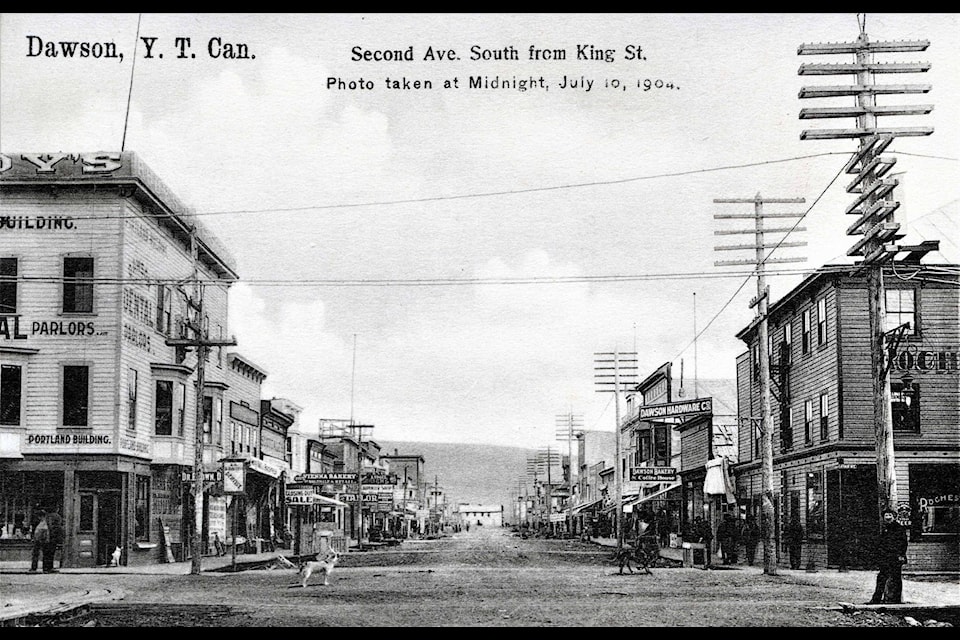My wife, Kathy, has an interest in old Yukon postcards, especially Dawson City cards — a popular subject for collectors. Ken Elder, of Ottawa, formerly a restoration architect with Parks Canada, is probably the most ardent collector of Yukon postcards. Elder has even published an exhaustive catalogue of thousands of Yukon specimens.
Vendors of postcards in Dawson City included Cribb’s Drug Store, the Japanese Bazaar, Landahl’s Emporium, Smith’s Book Store, Zaccarelli’s Fruit, Book and Stationery Store and Jimmy’s Place. All these vendors, except for Jimmy’s Place, commissioned their own lines of cards with a variety of views. The only Whitehorse vendor known to have commissioned postcards in the early days was the Bennett News Company.
| This postcard, sold by Landahl's Emporium, depicts miners working frozen deposits underground. Could the two young boys in the background have been added to the photo later, or were they part of the original photograph? (Courtesy/Gates Collection) |
According to Elder, the Canadian Post Office Department announced in late 1903 that half of the back of postcards could be used to inscribe a greeting or message. This seemed to have sparked a boom in picture postcards from the Yukon.
| Transportation was a popular theme for Yukon postcards. Pictures depicting sternwheel river boats going through Five Finger Rapid were especially common. (Courtesy/Gates Collection) |
The subjects depicted on these cards varied widely, including views from the gold rush. The Chilkoot Trail, Lake Bennett, Miles Canyon and the Whitehorse Rapid were popular subjects. Views of Dawson included panoramas taken from various perspectives, as well as street views and photos of specific buildings. Some of the impressive government edifices, such as the post office, commissioner’s residence and territorial administration building, were common examples. Robert Service’s cabin was often featured in later years.
Mining was another popular topic, with scenes showing sluicing operations, hydraulic workings and dredges being frequent choices. Transportation was another favoured subject, with sternwheel riverboats being the most common subject, especially those passing through Five Finger Rapid. Dog teams were popular selections, as were trains and stage lines, both summer (wagons) and winter (sleds).
Postcards depicting wildlife seemed to find favour with customers, especially photos of caribou herds swimming across the Yukon River.
Martha Black, a well-known pioneer and former Member of Parliament, loved wildflowers. Interestingly, in our collection, we have a postcard from Landahl’s Emporium with a photo taken in February of 1907. It shows several hundred of her pressed Yukon flowers on display in the Arctic Brotherhood Hall.
Mrs. Black won a competition for this display which was later featured in the Yukon Pavilion at the 1909 World’s Fair in Seattle. Years later, she had postcards showing selected species of wildflowers printed for her own personal use.
| This postcard from Landahl's Emporium, shows a 1907 exhibit of flowers mounted on card by Mrs. George (Martha) Black. The collection won first place in a competition and was later featured at the 1909 World's Fair in Seattle. (Courtesy/Gates Collection) |
It is interesting to read the brief messages written on some of the specimens that we have collected. For example, a postcard sent to L. J. Pinska in Minnesota in 1907, came from Martin Pinska, a merchant, of Dawson. “Received your card,” he wrote in the margins on the front of the card. “We had our first snow storm Sunday September 19, but it melted as fast as it landed.”
Weather was a popular subject for postcard messages. Take for example another postcard in our collection showing a cold day in Dawson: “Hope I won’t have to be here this winter and experience this scene, tho it is a dry cold and not as unpleasant as in some parts of the states.” The message, which was written across the front of the card by someone named Bell, was sent to her friend Miss Pearl McIntire of Manchester, New Hampshire.
Another card was addressed to Olaf Olson. Could this be the same person who owned and operated the Orpheum Theatre for a dozen years? Your guess is as good as mine on that one. Whether it is the image on the front, or the message, written by a tourist, or one of the locals, these cards represent a fascinating snapshot of bygone days.
Michael Gates is Yukon’s first Story Laureate. He is the author of six books of Yukon history. His latest book, “Dublin Gulch: A History of the Eagle Mine,” received the Axiom Business Book Award silver medal for corporate history. You can contact him at msgates@northwestel.net.
